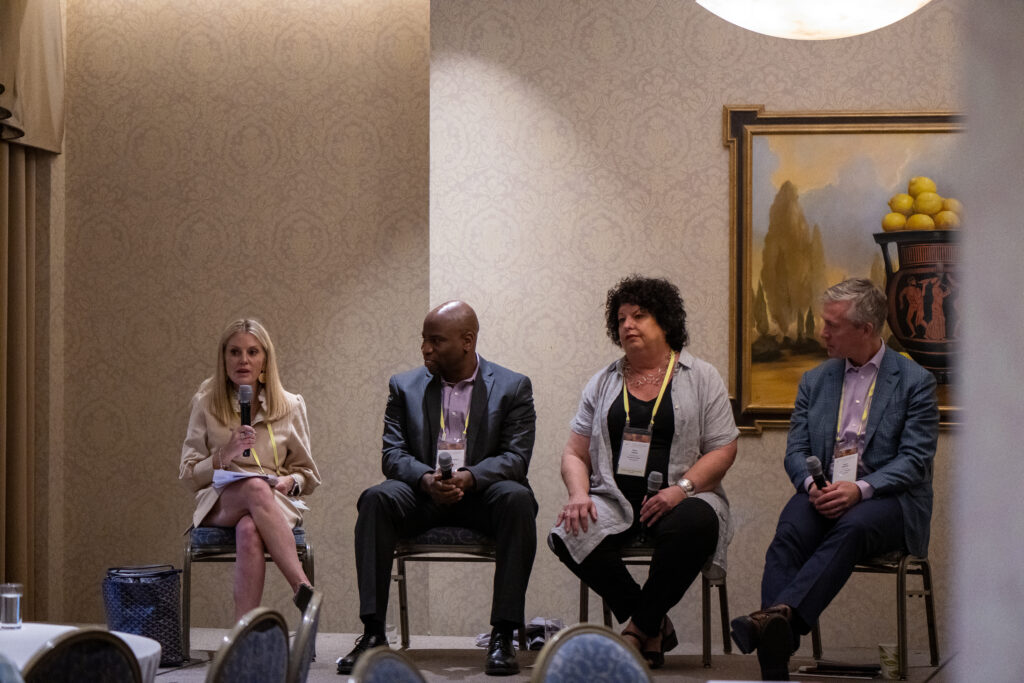Building and Maintaining Successful Board Chair-CEO Relationships

Liz Bonner, Nat Chioke Williams, Diane Kaplan, and Adam Gibbons speaking at Building and Maintaining Successful Board Chair-CEO Relationships at the 2022 National Forum on Family Philanthropy
NCFP Senior Program Consultant Tony Macklin attended NCFP’s 2022 National Forum on Family Philanthropy. Read on for Tony’s takeaways from Building and Maintaining Successful Board Chair-CEO Relationships.
“Will you let the other person be a whole person—be who they really are?”
That question came early in a session about the relationship between foundation board chairs and CEOs at the 2022 National Forum on Family Philanthropy. Denise Porche, executive director of the Island Foundation, facilitated the conversation with pairs from two foundations:
- Hill-Snowdon Foundation—Liz Bonner, board chair and fourth generation family member, and Nat Chioke Williams, executive director.
- Rasmuson Foundation—Adam Gibbons, board chair and fourth generation family member, and Diane Kaplan, president and chief executive officer. (Kaplan retired in December 2022).
Four themes emerged for ensuring successful CEO-board chair relationships:
- Get personal—Both pairs stressed the value of developing personal relationships, in and outside the office. Gibbons and Kaplan get out into nature or go for drinks. Bonner and Williams start their monthly check-ins with what’s going on in each other’s lives and the lives of their families.
- Find and keep alignment—Their personal relationships remain strong in challenging times because they took time early on to understand each other’s values and principles. Kaplan said, “You have to find where you align ideologically and align on the bigger vision for the foundation.” Williams noted that knowing each other’s personal convictions promotes a spirit of honest dialogue and open listening.
- Play defense for each other—Each pair told stories of times in which one person helped the other navigate family politics and dynamics. For example, when Kaplan wanted to hire more staff, Gibbons helped her think through the data and stories other board members would need to support the request. The two board chairs also described their work in keeping their peers focused on governance and strategy questions so that the staff executives had the full ability to manage their teams, operations, and grants and awards programs.
- Listen for opportunities to evolve—A board chair and CEO should maintain an ongoing feedback loop with board, committee, and family members. They’re listening for changes in the members’ personal and professional lives, family relationships, and expectations of relationships with the foundation. The CEO and board chair can then suggest adjustments to governance structures, board meeting agendas and frequency, and board engagement strategies. The CEO is also listening for opportunities to adjust communications and problem-solving methods based on different chairs’ preferred styles.
Their themes echoed the advice provided by other family foundation board chairs and CEOs in NCFP’s 2019 Passages Issue Brief Family Philanthropy Board Chairs: Leading with Joy and Effectiveness. Their conversation also reminded me of a lesson I learned while serving as executive director of the Roy A. Hunt Foundation:
Keep (re)setting context together—The foundation’s board chairs and their relatives were part-time volunteers with varying levels of interest in the many aspects of foundation governance and management. The chairs taught me to add more context and reminders in our written materials. In turn, I helped them create more time at board meetings for people to catch up on the topics and share stories that taught the younger generation the longer arc of the foundation’s work and decision-making.
The Hunt Foundation’s board chairs and I never discussed the question that started this post. But I know we would have answered “yes.” We gave each other latitude to be who were, working to build on each other’s strengths and shore each other up when we faltered. I count myself lucky to have had that experience, and I expect the speakers at the conference session do as well.
If you’re feeling the same gratitude, reach out to NCFP to add your own tips for successful board chair-CEO relationships and work. And if you’re running into challenges, don’t hesitate to ask NCFP for ideas or for connections to peers. You can also use these resources to learn more:
- Relationship Between the Board Chair and CEO webinar (NCFP webinar)
- Family Philanthropy Transitions (NCFP Passages paper)
- A Legacy Lives On: The Mayer and Morris Kaplan Family Foundation’s Successful Leadership Transition (NCFP Passages paper)
- The Collaboration Conference 2015: Lunch Plenary with Nat Chioke Williams and Ashley Snowdon Blanchard (75-minute video)
- Family Philanthropy Speaks: A conversation with Dimple Abichandani and Robin Snidow
Tony Macklin is a Senior Program Consultant at the National Center for Family Philanthropy (NCFP)
